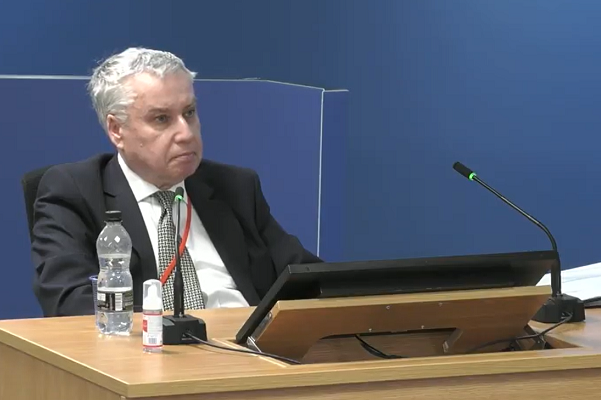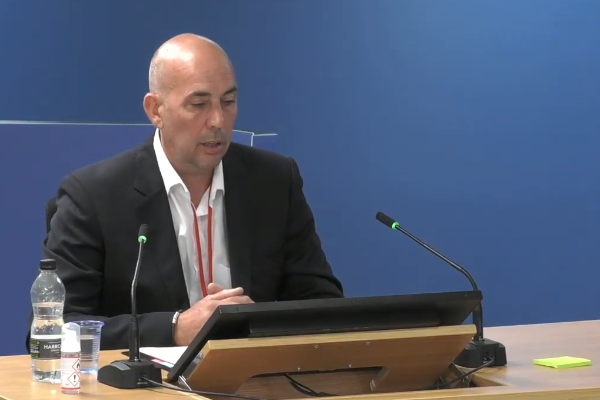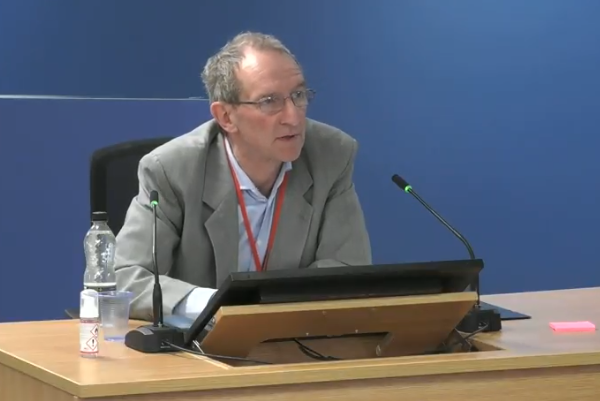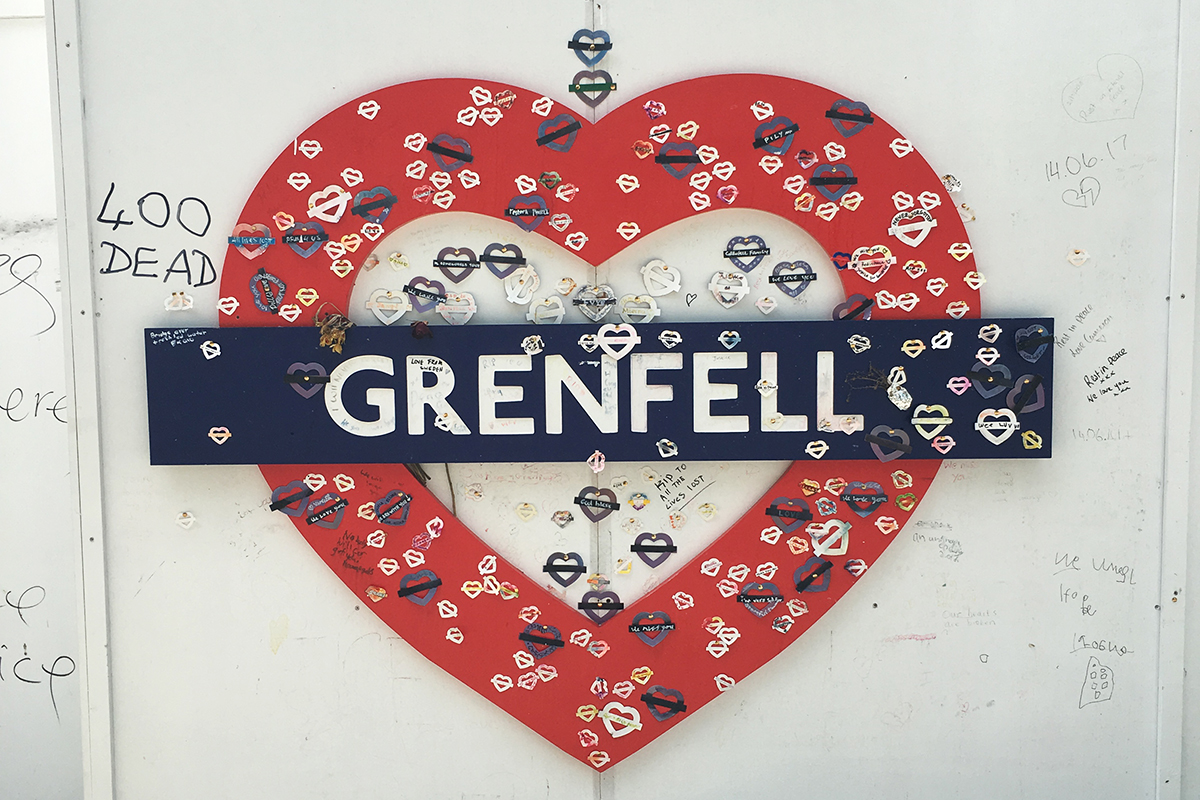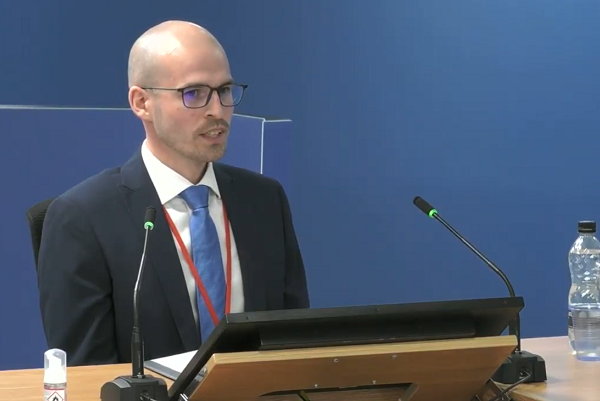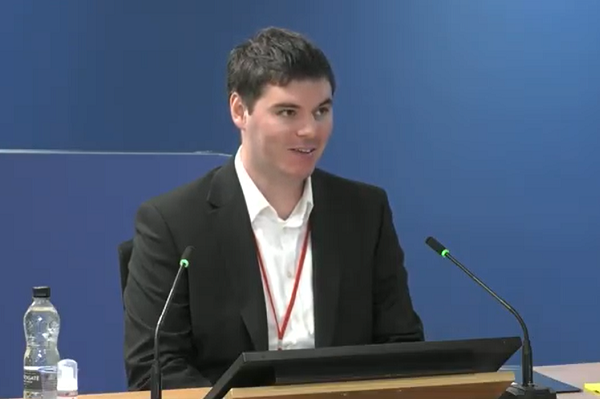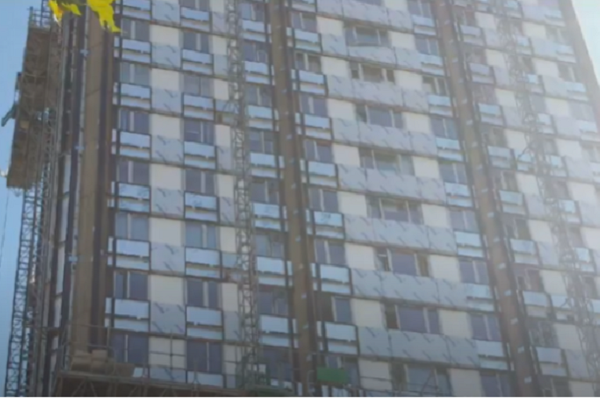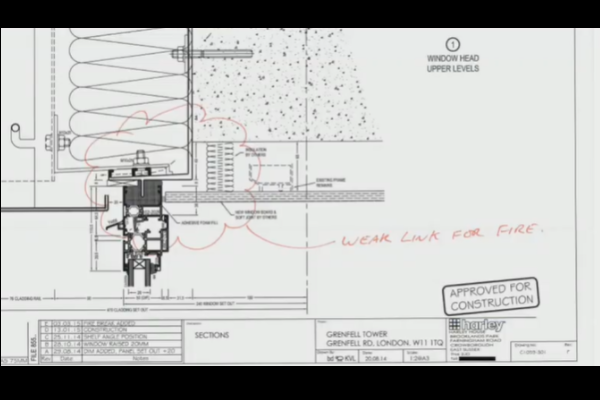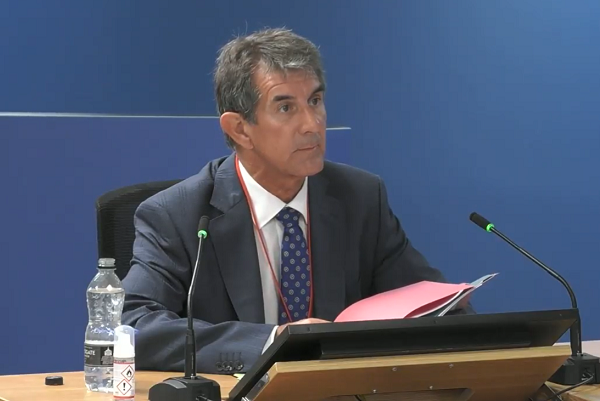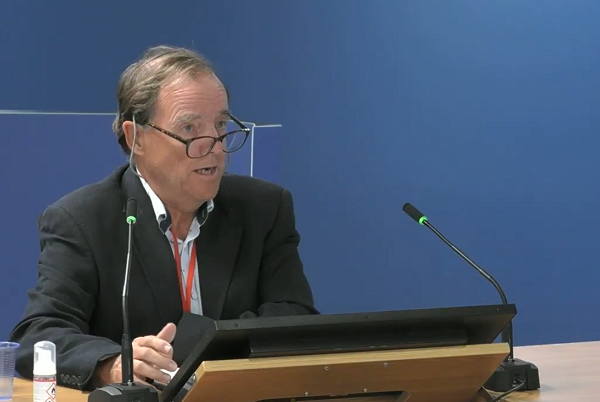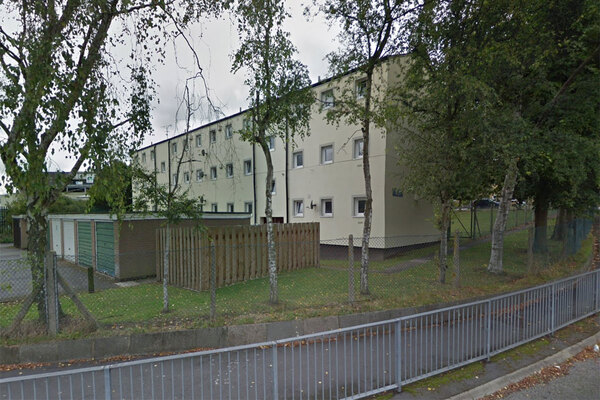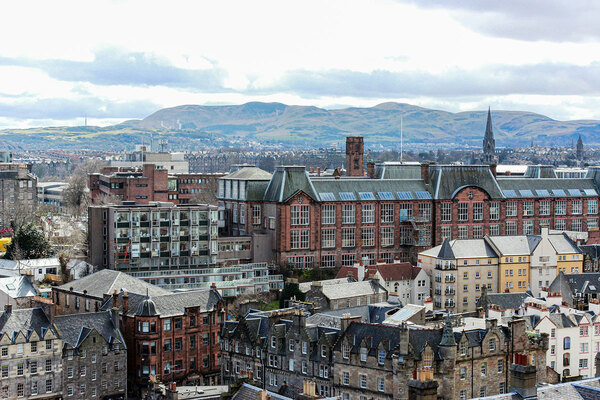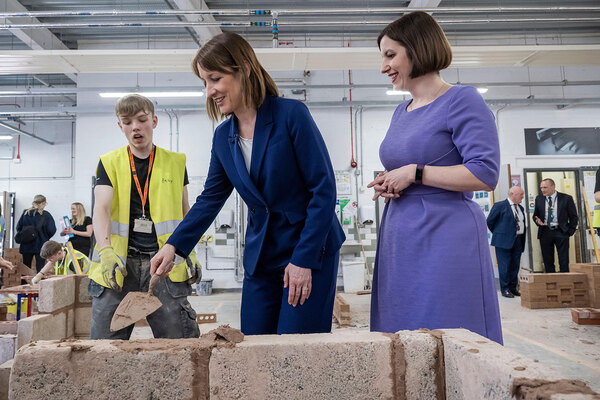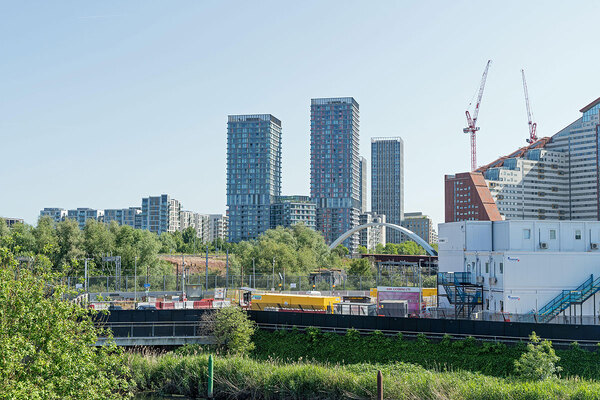Grenfell Tower Inquiry diary week 11: ‘Did you get the impression that Grenfell Tower was a guinea pig for this insulation?’
With witnesses’ evidence from the cladding sub-contractor, the firm that cut the deadly panels to shape, and the clerk of works who inspected the job, this was a week full of revelations at the Grenfell Inquiry. Peter Apps recaps the key points
The early selection of Celotex
Much of the most important evidence this week surrounded the selection of the combustible and non-compliant Celotex RS5000 insulation product for the tower.
Andrew McQuatt, who worked as project engineer on the Grenfell Tower refurbishment for consultancy Max Fordham, was asked about the genesis of this decision.
It began in summer 2012, when the consultancy decided it should “go for new-build targets” for thermal efficiency in the refurbishment.
Building guidance at the time required the walls of new buildings to achieve a ‘U-value’ of 0.15. That is a technical measurement for the amount of heat that escapes, and the lower it is the tougher it is to achieve. Refurbishment jobs are required to achieve a U-value of just 0.3, so this was double the target.
Mr McQuatt explained that he did not believe this was impossible, because the work being done was similar to a new-build project.
“If you were to build a tower from scratch, and you were to build a concrete tower, apply insulation to that concrete frame and apply rainscreen, that didn’t seem any different from doing the renovation,” he said. “Because it was so similar to how you might construct a new build, those new-build targets didn’t seem crazy.”
He added that planning guidance in London made thermal efficiency “the top tier of that hierarchy” of priorities in construction.
Nonetheless, as the project got under way, the architects described the target as “a bit aspirational” and “over the top”.
They initially explored ways of meeting the target using non-combustible Rockwool insulation, but “discounted” this option because they believed it would need to be too thick.
However, these calculations were basic. Mr McQuatt was shown assessments by the inquiry’s expert Paul Hyett which suggested the target could in fact have been met with Rockwool - a conclusion he accepted may have been “a bit more accurate” than the team’s estimates.
With Rockwool discounted, the architects and Max Fordham discussed using Kingspan – a plastic foam alternative that has higher insulating properties but is far more combustible.
However, when Mr McQuatt tried to log on to the Kingspan website, he realised he did not have a password. But he did have a password for rival manufacturer Celotex, so he went to their website instead. He identified a product made of polyisocyanurate (PIR) plastic branded FR5000, which had the requisite insulating property.
In an email to architect Bruce Sounes of Studio E in August 2012, he wrote that Celotex “is the only type of product that will give us the required performance”.
But he had carried out no checks about its fire safety or its compliance with regulations.
“It sounds so silly to say this now, with all that’s passed, but it just never occurred to me in any way that something that I could just go on to a website and select would be so unsafe or have the potential to be so unsafe,” he said. “I had done a lot of projects, I had seen it again and again and again. In my mind, it was just a common material that’s used.”
But what Mr Sounes saw was an expert recommending him a suitable product. He would put it into his specification with no further checks on its compliance.
‘A guinea pig for RS5000’
Earlier in the week we heard from Ben Bailey (pictured above), the project manager from cladding sub-contractor Harley Facades, who explained how Celotex was finally purchased and used on the tower.
Ben Bailey is the son of Ray Bailey, managing director at Harley Facades. Aged just 25, Ben Bailey was leading only his second project, having graduated from Oxford Brookes University with a degree in business and management in May 2013 – less than two years before he took over the £2.6m Harley contract at Grenfell.
He had an NVQ in construction site management and had helped out at Harley in school and university holidays, but he had no meaningful understanding of building regulations or how they applied to cladding systems. It was he who purchased the non-compliant Celotex insulation for the tower in 2015.
This story really started in 2014 when he was working on another project – Merit House in Colindale. Then, he had contacted Celotex to see if it had any suitable insulation products for the project.
Celotex had said it did not, but had gleaned from Mr Bailey that Harley Facades would soon be working on Grenfell Tower and made a note to follow up for a potential sale.
In summer 2014, Celotex got a pass in a large-scale test for one of its insulation products (RS5000 – not the FR5000 originally specified for Grenfell). This meant it could be used on high rises, but only in the exact combination tested, a system that used cement fibre panels.
In August 2014, a Celotex salesperson emailed Harley to say RS5000 had passed the test and was therefore “acceptable for use on buildings above 18m”.
In February 2015, Ben Bailey took over the discussions with Celotex about this purchase. He sent the company some design drawings. Jonathan Roome, a salesperson at Celotex, then replied in March to enquire which materials supplier he would buy the insulation from, noting that he would “make sure… pricing is looked after for you”.
Mr Bailey was then offered a 47.5% discount on the insulation by supplier SIG, knocking down the price to around £45,000.
He claimed that this discount was not unusual for a bulk order. “In terms of how do we arrive at a discount such as that, I think the answer is you order lots of it,” he said.
Later emails were then disclosed, which showed that Celotex approached Harley and asked permission to use Grenfell Tower as a “case study” for RS5000 – one of the first high rises it had ever been installed on.
“Did you get the impression that Grenfell Tower was, as it were, a guinea pig for RS5000?” asked Richard Millett, counsel to the inquiry.
“That’s not a thought that crossed my mind,” Mr Bailey replied.
The insulation switch
In Mr Bailey’s evidence we also learned the answer to one of the mysteries that has hung over the refurbishment since the fire. Why was Celotex specified but 267 sq m of insulation made by rival firm Kingspan installed on the tower’s walls (pictured above, mid-installation)?
It transpired that in July 2015, supplier SIG “mistakenly sold an order of Celotex RS5000 intended for Grenfell Tower elsewhere”, meaning there was likely to be a delay of four working days in its delivery to the site.
“Are you joking?!” Mr Bailey emailed after being told this. “Is K15 [a Kingspan product] held in stock at the same thickness?”
He then asked his colleagues to check the certificate for the product to ensure it was the same as Celotex. He told the inquiry that the timestamp on an email suggesting he ordered it around a minute later was “wrong”.
Asked whether the delay was really so “critical” that the products needed to be switched, Mr Bailey said: “I appreciate what you’re saying, but when you have got limited materials, that delay can be quite significant. Because you could have teams of fixers not doing anything because there isn’t any material… Rydon [the lead contractor] was also putting pressure on sub-contractors to stick to programme.”
The client – Kensington and Chelsea Tenant Management Organisation (KCTMO) – was never informed about the product switch.
A weak link for fire
In a mammoth cross-examination over two days, Mr Bailey was also forced to answer some difficult questions about missing cavity barriers around windows.
Getting to the bottom of why these were not installed – as required by guidance – has been a major theme of this phase of the inquiry so far. It is important because the inquiry has already found that fire quickly broke out of the window in the kitchen and was able to rapidly enter flats as it ripped up the building.
Mr Bailey was grilled about an email he received from Chris Mort, technical director at cavity barrier supplier Siderise, in March 2015. Mr Mort said he had seen some Harley drawings and wrote: “I have highlighted the weak link so to speak in terms of fire.”
He attached a diagram on which he had drawn a bubble around the bracket at the top of the window and annotated “WEAK LINK FOR FIRE” in capital letters (pictured above). He then shaded in orange on another drawing to show that cavity barriers needed to come down to the top of the window head.
But Mr Bailey did not act on this email. It came in the context of a debate among the team about whether two hour fire stopping or 30 minute cavity barriers were required.
Mr Bailey claimed he believed that Mr Mort’s concern was applicable only if they were trying to achieve the two-hour protection, and as this route was not taken, the issue was not relevant. But this was not what Mr Mort meant. In his own witness statement, he said: “It was a clear error and I felt I should highlight it.”
Mr Bailey did not pass the warning on to the architects, building control or lead contractor Rydon.
“Why did you not go back to Mr Mort and ask him what he meant?” Mr Millett asked.
“I don’t know,” Mr Bailey replied.
“Why did you not take this to the architect and say, ‘The manufacturer has identified a weak link for fire on our drawings, could you please help us’?” asked Mr Millett.
“Because I read it in the context of a 120-minute firestop, and that issue was shortly afterwards cleared up, to my recollection,” Mr Bailey said in response.
‘I’ve got to put it to you that this was something of a missed opportunity’
On Wednesday the inquiry heard from Geof Blades, sales director at CEP Architectural Facades, the firm that cut the highly combustible polyethylene-cored cladding panels to shape, bent them to hang on the rails and sold them on to Harley for installation on the tower.
Mr Blades (pictured above) was primarily grilled about two things: whether he actively encouraged the use of aluminium composite material (ACM) for the tower, and why a safer ‘fire-rated’ product was not used on Grenfell.
As to the first issue, Mr Blades first got involved in the project in spring 2012 when the architects contacted him and asked for suggestions regarding “an appropriate cladding system”. He later attended meetings, bringing along the salesperson for Arconic – the firm that ultimately sold the product – and discussing ACM options.
CEP had an account with Arconic and fabricated mainly ACM products.
In January 2013, he was asked to provide a quote for “VM Zinc” cladding. But instead, he offered estimates of the cost of Reynobond (an Arconic ACM product) painted to look like zinc. “You put forward Reynobond when you weren’t asked for it – that’s right, isn’t it?” asked Mr Millett.
“Yes, at this point,” Mr Blades replied, explaining that he felt he was offering an option that would be “suitable” for the job.
He believed Reynobond was acceptable for high rises because he understood it to have a Class 0 rating for fire.
Mr Blades was shown an email from Deborah French, UK sales manager at Arconic, after Reynobond was selected. The letter offered him “lunch or dinner at some point” for his “hard work and perseverance in putting Reynobond forward”.
He told the inquiry: “All I can say to this is the three companies acted very professionally and I was never taken out for lunch by anybody.”
On the question of why a less combustible version of the product was not chosen, Mr Blades initially said he was not aware that one was available.
But he was then shown an email from 3A – a rival ACM supplier – that said it could offer FR. The email said of Arconic: “Alcoa can offer this [as well] but they will charge considerably more. Alcoa won’t change their core until they are forced to due to changes in the fire regulations, else Reynobond [the firm’s cladding product] will become more expensive.”
It also emerged that less combustible ACM was used in a mock-up of the cladding system on the walls of the tower, but when it came to the main job the companies reverted to polyethylene.
“I’ve got to put it to you that this was something of a missed opportunity?” said Mr Millett.
“With hindsight, yes,” Mr Blades replied.
The clerk of works
The last witness of the week was Jon White (pictured above), a clerk of works, who said he was employed to act as “the eyes and ears” of KCTMO, monitoring what was happening on the construction site.
He was shown a description of the services he was supposed to provide, which included a requirement that he should be “familiar with legal requirements and checking that the work complies with them” and check design drawings.
But he did not check the drawings and had no real knowledge of the requirements of building regulations for a rainscreen cladding system, insisting that his role was more limited and focused mostly on how well residents were being treated.
He said he checked compliance by making sure that building control inspectors at the Royal Borough of Kensington and Chelsea had signed off the work – but he accepted that he made no individual assessment himself.
Mr White made at least 10 trips up in a mast climber to inspect the cladding, going down over every floor and reporting any ‘snags’. But he did not realise it was made of a combination of combustible materials that did not comply with regulations.
He said that his impression of the cladding works overall was that it “looked very neat”.
“If a job looks neat and tidy, it’s a good way of knowing it’s being done properly,” he said.
The inquiry continues next week with another witness from the clerk of works.
Grenfell Tower Inquiry: week 11 headlines
Warning of ‘weak point for fire’ missed by cladding sub-contractor at Grenfell Tower
An email warning of a “weak point for fire” at the top of the planned new windows on Grenfell Tower did not result in the designs being amended to include fire barriers as required by guidance.
Insulation on Grenfell substituted to avoid delivery delay of just four working days
The cladding sub-contractor for Grenfell Tower substituted the insulation to avoid a delay in delivery of just four working days, without checking the new material’s fire performance.
Grenfell cladding manufacturer offered combustible product unless ‘forced’ not to, inquiry hears
The manufacturer of the cladding used on Grenfell would not offer a less combustible version of the product unless it was “forced to due to changes in the fire regulations” as doing so would make it “too expensive”, an email claimed.
Grenfell insulation selected without ‘basic’ fire checks to meet ‘aspirational’ thermal efficiency target
The insulation used on Grenfell Tower was originally suggested to meet an “aspirational” thermal efficiency target, without even any “basic checks” regarding its fire performance.
Grenfell Tower Inquiry phase two: weekly diaries
Module one: the refurbishment
Week one: A vivid picture of a broken industry
After a week of damning revelations at the opening of phase two of the Grenfell Tower Inquiry, Peter Apps recaps the key points
Click here to read the full story
Week two: What is the significance of the immunity application?
Sir Martin Moore-Bick has written to the attorney general requesting protection for those set to give evidence at the Grenfell Tower Inquiry. Peter Apps explains what the move means
Click here to read the full story
Week three: Architects of misfortune
This week saw the lead architects for the Grenfell Tower refurbishment give evidence to the inquiry. Peter Apps runs through the key points
Click here to read the full story
Week four: ‘I didn’t have any perception that it was the monster it’s become’
The architects continued to give evidence this week, outlining a lack of understanding of the fire risk posed by the cladding materials and its design. Nathaniel Barker reports
Click here to read the full story
Week five: ‘No adverse effect in relation to external fire spread’
As the Grenfell Tower Inquiry returns from its long absence, Peter Apps recaps the key points from a week of important evidence from the fire consultants to the refurbishment
Click here to read the full story
Week six: ‘I can’t recall any instance where I discussed the materials with building control’
Nathaniel Barker summarises what we learned from fire engineers Exova, architects Studio E and the early evidence from contractor Rydon
Click here to read the full story
Week seven: ‘I do not think I have ever worked with a contractor operating with this level of nonchalance’
Two key witnesses from contractor Rydon gave evidence this week. Peter Apps recaps some of the key points from a revealing week of evidence
Click here to read the full story
Week eight: ‘It haunts me that it wasn't challenged’
Four witnesses from contractor Rydon gave evidence this week. Lucie Heath recaps what we learned on the last week of evidence before the inquiry breaks for five weeks
Click here to read the full story
Week nine: ‘All I can say is you will be taken out for a very nice meal very soon’
This week the inquiry heard evidence from witnesses at Harley Facades, the sub-contractor responsible for Grenfell Tower’s cladding. Peter Apps recaps the key points
Click here to read the full story
Week 10: ‘As we all know, ACM will be gone rather quickly in a fire!’
As the Grenfell Tower Inquiry entered its 10th week, Jack Simpson recaps the key points from a week of important evidence from the refurbishment’s cladding contractor
Click here to read the full story
Week 11: ‘Did you get the impression Grenfell Tower was a guinea pig for this insulation?’
With witnesses from the cladding subcontractor, the firm which cut the deadly panels to shape and the clerk of works which inspected the job giving evidence this was week full of revelations. Peter Apps recaps the key points
Click here to read the full story
Week 12: ‘Would you accept that was a serious failing on your part?’
With the surveyor who inspected Grenfell Tower for compliance giving evidence, this was a crucial week from the inquiry. Dominic Brady and Peter Apps report
Click here to read the full story
Week 13: ‘Value for money is to be regarded as the key driver for this project’
With consultants to Kensington & Chelsea Tenant Management Organisation (KCTMO) giving evidence, attention at the Grenfell Tower Inquiry turned for this first time to the actions of the TMO and the council. Peter Apps reports
Click here to read the full story
Week 14: ‘Did it not occur to you at this point that your budget was simply too low?’
This week, for the first time in phase two, the inquiry heard from Kensington & Chelsea Tenant Management Organisation, the landlord that oversaw the fatal refurbishment of Grenfell Tower. Lucie Heath reports
Click here to read the full story
Week 15: ‘Have you ever informed the police that you destroyed documents relevant to their investigation?’
Witnesses from the Kensington and Chelsea Tenant Management Organisation (KCTMO) gave evidence for a second week, which began with a shocking revelation about withheld and destroyed evidence. Peter Apps recaps
Click here to read the full story
Week 16: ‘I conclude this was very serious evidence of professional negligence’
This week saw members of Kensington & Chelsea Tenant Management Organisation finish giving evidence, before the inquiry’s expert witnesses took the stand to make some highly critical assessments of the work they had seen before and during the refurbishment of Grenfell Tower. Jack Simpson recaps
Click here to read the full story
Grenfell Tower: a timeline of the refurbishment
Following the conclusion of module one of the Grenfell Inquiry’s second phase, Peter Apps presents a timeline of the key moments during the fatal refurbishment of the west London tower block
Click here to read the full story
Module two: the cladding products
Week 17: ‘It’s hard to make a note about this because we are not clean’
The start of the second module of the Grenfell Tower Inquiry phase two came with some huge revelations about the companies that sold the products used in the cladding system. Peter Apps reports
Click here to read the full story
Week 18: ‘It was just reckless optimism wasn't it?’
As the inquiry began cross-examining witnesses for the second module of its phase two work, the picture surrounding just how Grenfell Tower ended up wrapped in such dangerous materials became a little clearer. Nathaniel Barker was keeping an eye on proceedings
Click here to read the full story
Week 19: ‘And that was intentional, deliberate, dishonest?’
The Grenfell Tower Inquiry this week heard the shocking story of how the insulation manufacturer “manipulated” official testing and marketed its product “dishonestly”. Peter Apps tells the story
Click here to read the full story
Week 20: ‘We were outed by a consultant who we then had to fabricate a story to’
This week the inquiry investigated the actions of Kingspan – the manufacturer of one of the insulation products used in the tower’s cladding system. Dominic Brady reports
Click here to read the full story
Week 21: ‘It’s there in black and white isn't it? We see a complete absence of any consideration of life safety’
The story of insulation giant Kingspan’s testing and marketing of its combustible insulation for high rises was unpacked in minute detail this week. Peter Apps reports
Click here to read the full story
Week 22: ‘All we do is lie in here’
In the third week of evidence from insulation giant Kingspan, the inquiry continued to uncover shocking details about the firm’s behaviour both before and after the Grenfell Tower fire. Lucie Heath reports
Click here to read the full story
Week 23: ‘That would have come as an earthquake to you at the time, would it not?’
This week the inquiry took its deepest dive yet into the inner workings of the cladding manufacturer whose product has been blamed for the terrible spread of fire up Grenfell Tower. Nathaniel Barker reports
Click here to read the full story
Week 24: ‘Do you accept that Test 5B was Arconic's deadly secret’
The president of the firm that made and sold the cladding panels installed on Grenfell Tower was asked to account for the apparent concealment of “disastrous” fire tests on the product this week. Peter Apps reports
Click here to read the full story
Week 25: ‘This is quite an incredible list of omissions and missed instances, isn’t it?’
This week the Grenfell Tower Inquiry heard its first witnesses from the Building Research Establishment (BRE) - the testing house which carried out key fire tests on the Kingspan and Celotex insulation products which were later used on Grenfell Tower. Peter Apps reports.
Click here to read the full story
Week 26: 'You were taking an enormous risk, weren't you?'
Week 26 at the Grenfell Tower Inquiry was a key moment in understanding how dangerous products used on the tower came to be accepted by industry professionals. Dominic Brady reports
Click here to read the full story
Week 27: ‘What will happen if one building made out [of] PE core is in fire and will kill 60 to 70 persons?’
The most explosive evidence this week at the Grenfell Tower Inquiry came from those who did not attend, as the evidence which would have been presented to Arconic witnesses was displayed in their absence. Peter Apps reports
Click here to read the full story
Week 28: ‘This is a serious safety matter’
This week the Grenfell Tower Inquiry zeroed in on the British Board of Agrément, the body that produced “misleading” certificates which inspired trust in both the cladding and insulation used on the tower. Lucie Heath reports
Click here to read the full story
Week 29: ‘Is it true that Kingspan’s position… was to do its best to ensure that science was secretly perverted for financial gain?’
The final week in this section of the Grenfell Tower Inquiry primarily examined the attempts by insulation manufacturer Kingspan to lobby government after the fire. Peter Apps reports
Click here to read the full story
How the products used in Grenfell Tower's cladding system were tested and sold
As the section of the Grenfell Tower Inquiry examining how the products used in the cladding system were tested, marketed and sold comes to a close, Peter Apps summarises what we have learned about each of the products included in the system
Click here to read the full story
Module Three: the management of the tower
Week 30: ‘There is certainly a high probability that in the event of a fire the whole building can become an inferno’
The focus of the inquiry shifted this week to the actions of the social housing providers responsible for maintaining Grenfell Tower. Pete Apps recaps what we learned
Click here to read the full story
Week 31: ‘If we cannot get out people will die’
This week saw the former residents of Grenfell Tower enter the witness box to tell of their experiences attempting to raise complaints with the council and its managing agent. Pete Apps reports
Click here to read the full story
Week 32: ‘Let's hope our luck holds and there isn't a fire’
This week saw the return of the landlord of Grenfell Tower, Kensington and Chelsea Tenant Management Organisation (KCTMO), as senior staff members attempted to explain how vital fire safety protections at the block were allowed to fall into disrepair. Lucie Heath reports
Click here to read the full story
Week 33: ‘Isn't that a serious gap in the scope of a policy meant to safeguard vulnerable people?’
A slightly disjointed week at the Grenfell Tower inquiry saw further evidence from staff at building manager Kensington and Chelsea Tenant Management Organisation (KCTMO) interspersed with the views of a cladding expert. Peter Apps reports
Click here to read the full story
Week 34: ‘Some members of the community are doing their best to spread false information’
Jack Simpson covers all the major revelations from the past week of evidence at the Grenfell Inquiry, including evidence from Laura Johnson, director of housing at the Royal Borough of Kensington and Chelsea.
Click here to read the full story
Week 35: ‘I really didn’t like the champagne’
This week the Grenfell Tower Inquiry saw council witnesses, including former deputy leader Rock Feilding-Mellen and leader Nicholas Paget-Brown, questioned about their role in the story for the first time. Peter Apps reports
Click here to read the full story
Week 36: ‘Is that not a very incurious approach for a fire risk assessor?’
This week the Grenfell Tower Inquiry scrutinised the work of Carl Stokes, the man hired to carry out fire risk assessments for the block. Nathaniel Barker reports
Click here to read the full story
Week 37: ‘In giving that advice, weren’t you acting beyond your knowledge and expertise?’
A curtailed week at the Grenfell Tower Inquiry saw fire risk assessor Carl Stokes grilled over advice he gave regarding the tower’s cladding. Peter Apps reports
Click here to read the full story
Week 38: ‘Well it’s a bit more than that, isn’t it. He’s suggesting that you tell the LFB a lie’
The inquiry heard the mammoth cross-examination of KCTMO’s health and safety manager Janice Wray this week. Peter Apps reports
Click here to read the full story
Week 39: ‘What you said there was a grotesque understatement’
This week the inquiry continued to hear from former employees of Kensington and Chelsea Tenant Management Organisation, as well as two employees from the London Fire Brigade. Lucie Heath reports
Click here to read the full story
Week 40: ‘An exercise in concealment and half-truth’
Former KCTMO chief executive Robert Black gave his evidence to the inquiry this week and was asked to account for the various failures described over the previous six weeks. Peter Apps and Nathaniel Barker report.
Click here to read the full story
Week 41: ‘We should do nothing. This is not the sort of website we should be responding to’
This week saw the return of Robert Black, chief executive of Kensington and Chelsea Tenant Management Organisation (KCTMO), before the inquiry turned its attention to the defective smoke control system in the tower. Dominic Brady reports
Click here to read the full story
Week 42:‘They would leak as much as they leaked. They were what they were’
The Grenfell Tower Inquiry continued its in-depth investigation of the tower’s non-compliant smoke control system this week, with evidence from the various contractors involved in delivering it. Pete Apps reports
Click here to read the full story
Week 43:‘Contractors at the time were not generally aware of the importance of leaving holes unsealed’
This week the inquiry focused on two of the more overlooked areas of the Grenfell Tower fire, with evidence focusing on the gas pipelines and lifts within the west London block. It was a packed week, with five witnesses giving evidence. Jack Simpson reports
Click here to read the full story
Week 44:‘I've never seen a fully compliant firefighting lift in any local authority building, to this day actually’
This week the inquiry turn the focus onto the building’s defective lifts, with evidence from an expert, contractors who worked on them and a former engineer at KCTMO. Pete Apps reports.
Click here to read the full story
Week 45: ‘Don’t you find all this rather a surprising debate, given that the Equality Act was passed in 2010?’
The inquiry heard from expert witness Colin Todd this week, who gave his views about the work of risk assessor Carl Stokes as well as answered questions about his own guidance. Peter Apps and Nathaniel Barker report
Click here to read the full story
Week 46: ‘I think I've been very, very clear that is completely wrong’
This week the inquiry heard further expert evidence about fire risk assessor Carl Stokes’ actions, as the section of its work covering the management and maintenance of the tower concluded. Peter Apps reports
Click here to read the full story
Six key failures in the way Grenfell Tower was managed before the fire
Peter Apps recaps some of what we have learned about the actions of the Royal Borough of Kensington and Chelsea (RBKC) and Kensington and Chelsea Tenant Management Organisation (KCTMO) in the years before the fire.
Module one and two closing statements
Week 47: ‘An unedifying spectacle’
After a week of closing statements from the core participants involved in modules one and two, Lucie Heath recaps the key arguments of each group
Click here to read the full story
Module five: the fire brigade
Week 48: ‘They knew, and lives could and should have been saved’
The phase of the Grenfell Tower Inquiry examining the actions of the London Fire Brigade in the years before the fire kicked off this week with some major revelations. Peter Apps reports
Click here to read the full story
Week 49: ‘I'm not sure we've always taken every opportunity to learn as an organisation’
How the London Fire Brigade acted upon lessons from incidents in the years before the Grenfell Tower disaster came under the microscope this week at the public inquiry. Nathaniel Barker reports
Click here to read the full story
Week 50: ‘There is a culture in LFB that is very conservative. I think there is great comfort in what is familiar’
This week the inquiry heard how the London Fire Brigade (LFB) elected not to issue warnings about dangerous cladding before Grenfell and a detailed examination of its policy for checking high risk buildings. Pete Apps reports.
Click here to read the full story
Week 51:‘We teach firefighters to expect building failure’
An unusually brief week of evidence at the Grenfell Tower Inquiry explored how a fire service neighbouring London was taking a different approach to tackling blazes in high rises. Nathaniel Barker reports
Click here to read the full story
Week 52: ‘I actually think that there is a measure of incompetence at all levels’
Expert evidence concluded the current section of the inquiry with some stinging criticism of the London Fire Brigade (LFB). Pete Apps and Grainne Cuffe report.
Click here to read the full story
Module six: fire services
Week 53: ‘They make for chilling reading and harrowing listening’
The inquiry’s investigation into central government began this week with lawyers setting out their view on how and why firefighting policies failed. Peter Apps and Lucie Heath report
Click here to read the full story
Week 54: ‘Our consideration of evacuation at this time was something of a blind spot’
The development of policy on ‘stay put’, both nationally and for London, occupied the attention of the inquiry this week. Peter Apps reports
Click here to read the full story
Week 55: ‘My review is pretty scathing!’
In a week that included the 200th day of evidence in phase two of the inquiry, attention turned to the London Fire Brigade’s control room. Lucie Heath reports
Click here to read the full story
Week 56: ‘Why didn't we thump the table harder’
This week, the control room at the London Fire Brigade was examined further – both before and after the fire. Pete Apps and Lucie Heath report
Click here to read the full story
Week 57: ‘It was worse than slow, it was sluggish’
Former London Fire Brigade (LFB) commissioner Dany Cotton was the star witness this week, as the inquiry continued to delve into the brigade’s knowledge and training before the Grenfell Tower fire. Jack Simpson, Grainne Cuffe and Pete Apps report
Click here to read the full story
Week 58: ‘I don't think we deserve to ask for trust until we demonstrate different outcomes’
A current and former commissioner of the London Fire Brigade (LFB) wrapped up the inquiry’s investigation into the actions of the brigade before the fire. Grainne Cuffe and Peter Apps report.
Module six: testing and government
One of the major scandals of our time: key revelations as the Grenfell Tower Inquiry turns to government
The government was accused of “covering up” the risks of dangerous cladding as its “unbridled passion for deregulation” left it a “junior party” to the construction industry as the latest phase of the public inquiry opened today. Peter Apps summarises some of the main points
Click here to read the full story
Week 59: ‘Recent tests have apparently shown it continued to burn for 20 minutes after the flame was taken away’
After shocking opening statements, the Grenfell Tower Inquiry turned its attention to the work of Local Authority Building Control. Pete Apps reports
Click here to read the full story
Week 60: ‘You could have an exact repeat of the Dubai fire in any number of buildings in London’
The Grenfell Tower Inquiry turned its attention to the work of the National House Building Council this week, with shocking revelations about the extent of the warnings issued to central government before the fire. Peter Apps reports
Click here to read the full story
Week 61: ‘Mistakes are meant for learning, not repeating’
In the first hearings of the new year, the Grenfell Tower Inquiry heard closing statements from the firefighting section of phase two. Lucie Heath reports
Click here to read the full story
Week 62: Did it ever occur to you that this act of collaboration was, in one sense, corrupting?
The Grenfell Tower Inquiry returned to the work of the National House Building Council (NHBC) this week, with a new shocking revelation about the government’s actions in the immediate aftermath of the fire. Peter Apps reports
Click here to read the full story
Week 63: ‘It came after the general move to deregulation. So more regulation was not welcome’
The government’s focus on deregulation before the Grenfell Tower fire was placed in the spotlight this week with a series of shocking revelations about its failure to amend fire safety guidance. Pete Apps and Grainne Cuffe report
Click here to read the full story
Week 64: ‘I didn’t think ACM would be suitable for use in any high-rise buildings. I don’t think anyone did’
This week, the Building Research Establishment’s Dr Sarah Colwell gave more than three days of evidence, with some huge revelations about what was known about the dangers of aluminium composite material years before the fire and the mass confusion over the government’s building regulations. Peter Apps and Jack Simpson report
Click here to read the full story
Week 65: ‘Unless the government does something now about ACM panels, people will die’
Further evidence from the Building Research Establishment and the first government witnesses added new depth to our understanding of how warnings were missed before the Grenfell Tower fire. Peter Apps reports
Click here to read the full story
Week 66: ‘Was there a cover-up?’
The latest evidence from the Grenfell Tower Inquiry tracked the government’s failure to act on fire safety warnings right up until the months before the fire. Peter Apps and Grainne Cuffe report
Click here to read the full story
Week 67: ‘When exposed to a fire, the aluminium melts away and exposes the polyethylene. Whoosh!’
This week the inquiry heard disturbing new evidence about the failure of senior government officials to act on warnings about dangerous cladding in the years before the Grenfell Tower fire. Peter Apps reports
Click here to read the full story
Week 68: ‘Can we agree that was a pretty dangerous thing to have, all this falling on one man’s shoulders?’
Three senior civil servants gave evidence this week, including the official who had responsibility for building regulations guidance on fire safety in the years before Grenfell. Peter Apps, Lucie Heath, Stephen Delahunty and Grainne Cuffe report
Click here to read the full story
Week 69: ‘It was just unthinkable. You had the makings here of a crisis you could not comprehend’
This week, civil servant Brian Martin gave his long-awaited evidence to the Grenfell Tower Inquiry. Peter Apps reports
Click here to read the full story
Week 70: ‘Show me the bodies’
An important week at the Grenfell Tower Inquiry saw a dramatic conclusion to the mammoth cross-examination of civil servant Brian Martin, as well as the first politicians. Peter Apps and Lucie Heath report
Click here to read the full story
Week 71: ‘I have changed my schedule to fit this in. I do have an extremely busy day meeting people’
Three politicians who were responsible for building regulations before Grenfell appeared before the inquiry this week, including the former communities secretary Eric Pickles, who responded to the coroner’s letter following the Lakanal House fire. Peter Apps and Lucie Heath report
Click here to read the full story
Module Four: aftermath
Week 72: 'The system isn't broken. It was built this way'
This week the inquiry turned to the shocking story of the lack of support for bereaved and survivors in the immediate aftermath of the Grenfell Tower fire. Peter Apps, Lucie Heath, Grainne Cuffe and Jack Simpson report
Click here to read the full story
Week 73: ‘Most people would regard that as hopeless’
This week, the Grenfell Tower Inquiry heard about the Royal Borough of Kensington and Chelsea’s chaotic response in the immediate aftermath of the blaze, from the staff responsible for it. Pete Apps, Stephen Delahunty and Grainne Cuffe report
Click here to read the full story
Week 74: ‘Do you agree that RBKC was ill-prepared and incapable to meet its duties’
This week, Nicholas Holgate, former chief executive of the Royal Borough of Kensington and Chelsea, was grilled on his failure to hand over control of the aftermath of the fire, despite the borough’s lack of capacity. Peter Apps reports
Click here to read the full story
Week 75: ‘It still shocks me to the core that that’s how we treat our citizens in this country’
This week the inquiry heard witnesses from the housing management body discuss their role in the aftermath of the Grenfell Tower fire, followed by a range of witnesses from other organisations which supported the response. Peter Apps and Grainne Cuffe report
Click here to read the full story
Week 76: ‘I fear this will become our New Orleans’
This week the inquiry heard from central government figures and members of the London-wide emergency response arrangements. Peter Apps and Grainne Cuffe report
Click here to read the full story
Week 77: ‘The planning wasn’t done and there was nothing for us to be drawing on’
The Grenfell Tower Inquiry’s examination of the aftermath of the fire concluded with witnesses from central government. Peter Apps reports
Click here to read the full story
Module seven: expert evidence and closing statements
Week 78: ‘The abandonment of the ‘stay put’ strategy for high-rise residential buildings is essential’
This week the Grenfell Tower Inquiry heard a range of expert witnesses discuss their reports. Peter Apps and Grainne Cuffe report
Click here to read the full story
Week 79: ‘You could argue the system was created to enable people to circumvent the rules’
The Grenfell Tower Inquiry continued to hear expert evidence this week, with two senior figures in the world of fire safety academia criticising the government’s approach before and after the blaze. Peter Apps and Grainne Cuffe report
Click here to read the full story
Week 80: ‘The evidence points to wilful blindness and complacency towards safety’
As the inquiry moves into its final stages, lawyers for the key players gave statements about the evidence surrounding central government. Peter Apps reports
Click here to read the full story
Week 81: ‘This is Islamophobia. It’s racism. It is the elephant staring back at us in the room’
This week, closing statements covering the aftermath of the fire delivered a shocking new revelation and an expert toxicologist gave his views on the causes of the deaths. Peter Apps reports
Click here to read the full story
Module eight: further evidence relating to the deceased
Week 82: ‘Their chance to hear about the circumstances in which their loved ones died is the culmination of five years of waiting’
The Grenfell Tower Inquiry moved into its final module this week, with evidence relating to the circumstances in which the victims died. Peter Apps reports
Click here to read the full story
Week 83: ‘They died together as they lived: caring for one another’
A second week of evidence relating to the circumstances in which the victims of the fire died delivered more heartbreaking stories about their final moments. Peter Apps recaps
Click here to read the full story
Week 84: ‘Every decision affects someone who is an adored child, a beloved sister, a respected uncle, a needed mother’
The final week of oral evidence for the Grenfell Tower Inquiry’s second phase contained more heartbreaking evidence about the deaths in the tower. Peter Apps reports
Click here to read the full story
Closing statements
Week 85: ‘The merry-go-round turns still, the notes of its melody clearly audible in the last few days’
The Grenfell Tower Inquiry returned this week for closing statements from lawyers representing the bereaved and survivors and the various parties under scrutiny for the fire. Pete Apps reports.
Sign up for our weekly Grenfell Inquiry newsletter
Each week we send out a newsletter rounding up the key news from the Grenfell Inquiry, along with the headlines from the week
Already have an account? Click here to manage your newsletters
The organisations involved in the refurbishment of Grenfell Tower
Picture: Jon Enoch
KCTMO: Kensington and Chelsea Tenant Management Organisation, the arm’s length management organisation responsible for providing housing management to Grenfell Tower. It was the end client which procured the refurbishment and oversaw it.
Rydon: Main contractor. It won a tender for the ‘design and build’ of the refurbishment project in March 2014, with a contract signed in October. It then held overall responsibility for the work, sub-contracting various elements to more specialist firms.
Celotex: The manufacturer of the RS5000 insulation which formed the majority of the insulation on the tower. The product is made from a combustible plastic called RS5000.
Arconic: A large multinational aluminium company, which manufactured and sold the Reynobond PE 55 cladding panels which were installed on the tower.
RBKC: As well as ultimately owning the tower, the Royal Borough of Kensington and Chelsea provided the ‘building control’ function for the refurbishment. This involved providing a completion certificate which effectively signed off the project as compliant with building regulations.
Studio E: Architect – first engaged by KCTMO as the principal designer for the wider refurbishment, it became a sub-contractor following Rydon’s appointment in 2014, working under the standard RIBA terms of business.
Harley: Specialist sub-contractor for the cladding. It was in contract with Studio E before Rydon was appointed, and then struck an agreement with Rydon for the design of the facade works.
Exova Warringtonfire: Fire engineer. Appointed by KCTMO in mid-2012 to provide a fire strategy for the building as it stood and for the refurbishment work. Three versions of the refurbishment version were produced, the last in November 2013. It provided ongoing advice after this point but was not directly engaged by Rydon.
CEP: The fabricator, responsible for cutting the panels into cassettes. CEP was one of a small number of ‘approved’ fabricators which worked closely with Arconic. Also supplied the window frames.
Max Fordham: The engineering consultant which worked for the TMO providing advice on energy strategy and sustainability. It was Max Fordham that identified Celotex insulation as a product which could meet the target insulation performance and was also thin enough to fit the design dimensions.
Kingspan: Produced and sold a smaller amount of combustible K15 insulation which was used on the tower.
Siderise: Produced and sold the cavity barriers.
Aluglaze: Produced and sold the window panels.
Artelia: The construction, design and management co-ordinator, employer’s agent and quantity surveyor, assisting KCTMO with its management of the contract.
Osborne Berry: The building contractor appointed by Harley to fit the cladding and window systems.
Kevin Lamb: An independently outsourced specialist cladding designer which provided Harley with detailed design drawings.
John Rowan and Partners: The clerk of works reporting to the TMO, responsible for site inspection and monitoring.
SD Plastering: A sub-contractor responsible for fitting the window surrounds.
JS Wright: A mechanical and electrical sub-contractor. It will have little involvement in module one.
Curtins Consulting: A structural engineer reporting first to KCTMO and then to Rydon. They will also have little involvement in module one.

